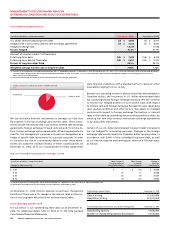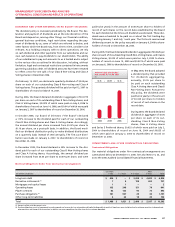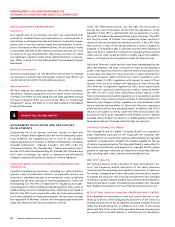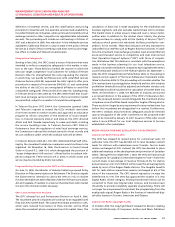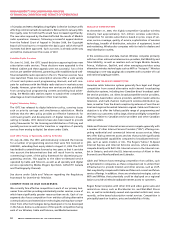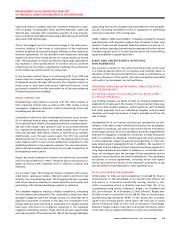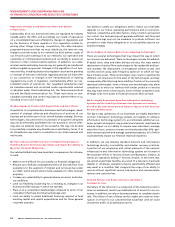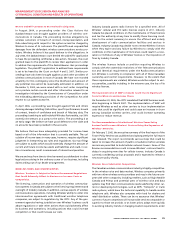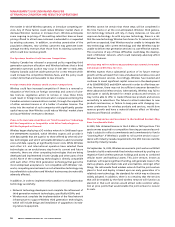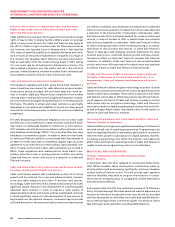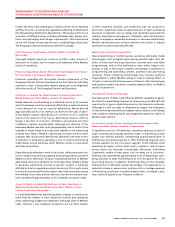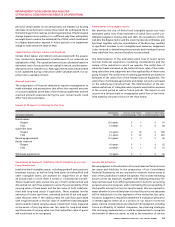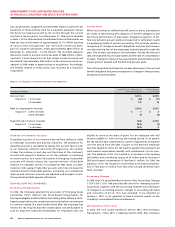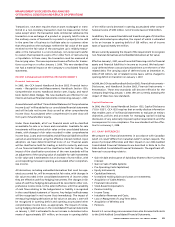Rogers 2006 Annual Report Download - page 60
Download and view the complete annual report
Please find page 60 of the 2006 Rogers annual report below. You can navigate through the pages in the report by either clicking on the pages listed below, or by using the keyword search tool below to find specific information within the annual report.
56 ROG ERS COM MUN IC AT I ONS INC . 2006 ANNUAL RE P ORT
MANAGEMENT’S DISCUSSION AND ANALYSIS
OF FINANCIAL CONDITION AND RESULTS OF OPERATIONS
the market in which Wireless operates, or introduce competing ser-
vices. Any of these factors could reduce Wireless’ market share or
decrease Wireless’ revenue or increase churn. Wireless anticipates
some ongoing re-pricing of the existing subscriber base as lower
pricing offered to attract new customers is extended to or requested
by existing customers. In addition, as wireless penetration of the
population deepens, new wireless customers may generate lower
average monthly revenues than those from its existing customers,
which could slow revenue growth.
The Spectru m Auction Could Increase Competition.
Industry Canada has released a proposed policy regarding third
generation spectrum allocation and Wireless believes that a third
generation spectrum auction may occur in late 2007 or early 2008.
Industry Canada could set aside spectrum for a new entrant which
could increase the competition Wireless faces, and the policy could
contain terms that are favourable to new entrants.
Foreign Ownership Changes Could Increase Competition.
Wireless could face increased competition if there is a removal or
relaxation of the limits on foreign ownership and control of wire-
less licences. Legislative action to remove or relax these limits
could result in foreign telecommunication companies entering the
Canadian wireless communications market, through the acquisition
of either wireless licences or of a holder of wireless licences. The
entry into the market of such companies with significantly greater
capital resources than Wireless could reduce Wireless’ market share
and cause Wireless’ revenues to decrease.
There Is N o Guarantee that Wireless’ Third Generation Technology
Will Be Comp etitive or Compatible with Other Technologies or
Will Be Deployed as Planned .
Wireless began deploying a 3G wireless network in 2006 based upon
the UMTS/HSDPA standard, which Wireless expects will provide it
with data speeds that are superior to those offered by other 3G wire-
less technologies and which will enable Wireless to add incremental
voice and data capacity at significantly lower costs. While Wireless
and other U.S. and international operators have selected these
technologies as an evolutionary step from its current and future
networks, there are other competing technologies that are being
developed and implemented in both Canada and other parts of the
world. None of the competing technologies is directly compatible
with each other. If the third generation technology that gains the
most widespread acceptance is not compatible with Wireless’ net-
works, competing services based on such alternative technology may
be preferable to subscribers and Wireless’ business may be materially
adversely affected.
In addition, in order to implement this transition to third generation
technology successfully:
• Network technology developers must complete the refinement of
third generation network technologies, specifically HSDPA; and
• Wireless must complete the implementation of the fixed network
infrastructure to support Wireless third generation technologies,
which will include design and installation of upgrades to its exist-
ing network equipment.
Wireless cannot be certain that these steps will be completed in
the time frame or at the cost anticipated. Wireless’ third genera-
tion technology network will rely, in many instances, on new and
unproven technology. As with any new technology, there is a risk
that the new technology Wireless has chosen for its network will not
perform as expected, that Wireless may be unable to integrate the
new technology with current technology and that Wireless may be
unable to deliver next generation services in a cost-effective manner.
The occurrence of any of these difficulties could delay the develop-
ment of Wireless’ network, which could materially adversely affect
Wireless’ business.
Wireless May Fail to Achieve Expected Revenue Growth from New
and Advanced Wireless Services.
Wireless expects that a substantial portion of its future revenue
growth will be achieved from new and advanced wireless voice and
data transmission services. Accordingly, Wireless has invested and
continues to invest significant capital resources in the development
of its GSM/GPRS/EDGE and HSDPA network in order to offer these ser-
vices. However, there may not be sufficient consumer demand for
these advanced wireless services. Alternatively, Wireless may fail to
anticipate or satisfy demand for certain products and services, or
may not be able to offer or market these new products and services
successfully to subscribers. The failure to attract subscribers to new
products and services, or failure to keep pace with changing con-
sumer preferences for wireless products and services, would slow
revenue growth and have a material adverse effect on Wireless’
business and financial condition.
Wireless’ E xpansion and Investment in the Inukshuk Business May
Have Considerable Risks.
In 2000, Fido obtained licences in the 2.5 MHz or MCS spectrum. This
spectrum was acquired in a competitive licencing process and accord-
ingly is subject to rollout commitments and commitments to fund a
“Learning Plan”. If Wireless is unable to roll out the service in accor-
dance with Industry Canada requirements, the MCS licences could be
revoked by Industry Canada.
On September 16, 2005, Wireless announced a joint venture with Bell
Canada to build a nationwide fixed wireless network by pooling our
respective fixed wireless spectrum holdings and access to combined
cellular tower and backhaul assets. This joint venture, known as
Inukshuk, will require significant funding, will generate losses in the
start-up phases, and entails risks and uncertainties. Amongst other
things, the nationwide fixed wireless network that the joint venture
plans to fund and deploy is based upon an early generation of a
relatively new technology, the standards for which may not become
widely adopted. In addition, there is no certainty that the services
that will be enabled by the fixed wireless network will function as
planned or that such services would attract wide customer adop-
tion at price points that would enable the joint venture to recover
its costs.


